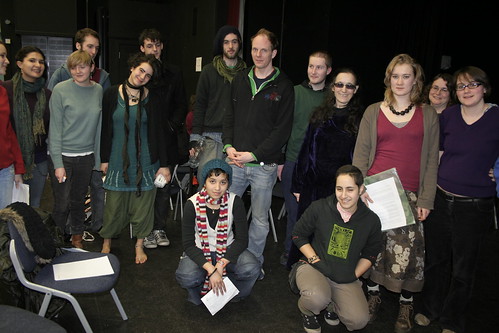
…to know which way the wind blows (so said Mr. Dylan). That’s right, you don’t need a weatherman, you need me: this is my first post of Activist Winds, my point source emission-contribution to the activist babble. And the title of this post (a reference to the militant off-shoot of the 60s US student peace movement) is apt, because we’re told that student unrest is back (The Times).
This 7 days I’m writing to you from the heart of what has been described as revival of the spirit of the 60s (The Scotsman). In protest to what they see as the Universities support for Israeli violence against Gaza, Students have been occupying George Square Lecture Theatre at the University of Edinburgh since Wednesday, and after negotiations with the administration, have won considerable concessions including scholariships, the organisation of aid collections, a lecture series about the history of the conflict.
The protest has been both historic in its sucesses and the support it’s recieved with MPs, journalists, academics and peers paying their respects. Other actions up and down the country have had similar victories. And like everything that causes a splash, it has had its enemies, its internal wranglings, and its lessons to be learned.
Edinburgh has a specific context: in November the Israeli ambassador spoke (The Journal) on the University’s bahalf causing considerable anger in the student population. This is the backlash, and the University has no right to be suprised.
Perhaps they made concessions from the start because from the very beginning of the occupation the University, through its Secretary, has been willing to meet with the students and offer concessions. Their willingness to discuss things on a regular basis and invite students into their (if arduous) processes has to be comended – as does their genuine willingness to accomodate the protest by allowing freedom of movement and supplies. In return, protestors have treated the space with respect and been reasonable and realistic with their demands.

The occupation was visited by members of the Universities and Colleges Union Exec.
The occupation has, of course, had its own backlash. On Friday the Labour Students faction of the Students Association decided that the occupation was “intimidating.” This is of course bullshit, but if you think Israel is awesome, then naturally you’re gonna find some way of arguing against freedom of protest. Trouble is, people do consider it reasonable to say that occupying a lecture thatre is disruptive – and the likes of Labour Students are more than happy to hijack these reasonableists for their own ends. So lesson one is: fight back.
Tip #1: Fight the PR war. Flyer everyone outside. Send texts out to get your friends to visit, even if they don’t stay. Write regular updates explaining your aims and inviting people in. Get the media down and make sure they hear and sympathise with your side of the story. Arguments are not won by doing nothing and controvosy can be a very powerful force for change – but you must meet the action with message. The anti-protest crowd have been shown to be way to the right of most University administrations, let alone the average student. With the right message they can easily be alienated.
Tip #2: Find a way to win. With the university sympathy and a willingness to cooperate on both sides, the protest could come to a positive conclusion, but this was not an accident. Edinburgh uni is a political place and that makes things easier, but P&P has done a lot here to fertilise the ground by winning elections for the President and Rector. With this in hand, the occupation has done well by being realistic about its position and willing to make concessions themselves.
Such an occupation can easily end up alienating those not involved, widening a gap between campaigners and the administration, and disempowering those inside. But with the right thinking, the Edinburgh occupation managed to harness support, create positive outcomes, and galvanise a new group of activists – and all of these strengths can, of course, be very widely applied.
This post was originally published on the People & Planet Blog.
Leave a Reply